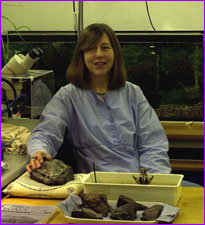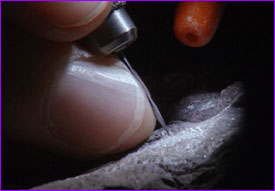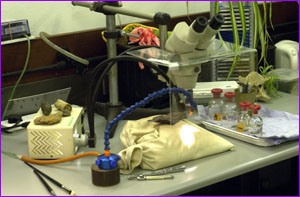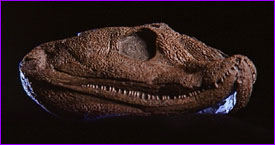 |
 |
|
|  One hand on a specimen of
Ichthyostega, a tetrapod that lived during the Devonian Period, Sarah
Finney takes a break from her work at the University of Cambridge.
One hand on a specimen of
Ichthyostega, a tetrapod that lived during the Devonian Period, Sarah
Finney takes a break from her work at the University of Cambridge.
|
Confessions of a Preparator
by Sarah Finney
My progress toward becoming a preparator began, I think, quite early in my
life. While growing up along the Welsh border with England, I used to collect
fossils from deposits of the Silurian and Devonian periods (438 to 360 million
years ago). This pursuit gave me an intrinsic feel for and love of fossils.
Later I studied archeology and also worked in this field for a number of
years.
It was during my stint in archeology that I learned the preparator's most vital
tool: patience. (Or is it just stubbornness?) This is particularly pertinent
when working on the material from the Devonian of East Greenland, which forms
the foundation of our research. That's because most of the specimens are in
fairly intractable matrix, the rock in which fossils are embedded.
My job is a matter of wearing the matrix away grain by grain using dental
drills and a lot of one-millimeter-diameter tungsten carbide rod. I cut this
rod to length, mount it in a pin vice, and sharpen it to a fine point on a
bench grinder with a 120-grit wheel. Because of the brittle nature of tungsten
carbide and the hardness of the matrix, I am forever breaking the tip off my
needle. If a genie were to appear before me one day, I would not wish for a new
car or a swimming pool in my back garden but for an ever-sharp point that never
breaks.
I carry out all my work under a binocular microscope, because most of our
specimens are quite small, and we are interested in detailed points of anatomy.
In fact, this meticulous preparation is a speciality of our lab. Using a
microscope also enables me to see the fine color or textural distinction
between bone surface and matrix.
 One grain at a
time: Fossil preparation requires concentration, a steady hand, and a depthless
well of patience.
One grain at a
time: Fossil preparation requires concentration, a steady hand, and a depthless
well of patience.
|
|
One characteristic of the early tetrapods that we study is that the dermal
bones of the skull have a sculpted or ornamented surface texture. (Imagine an
overturned egg carton in miniature.) This surface is particularly difficult to
prepare and slows up the whole process. (Imagine encasing that egg carton in
concrete and then having to excavate it.) I enjoy the challenge, however, and
there is also the added interest of chasing sutures, the lines where the
various bones of the skull meet, and sensory pits, the slight depressions in
the skull that contain sensory cells.
There are no tools that are specifically made for mechanical preparation, so we
tend to rely on "found" devices such as dental drills. I have several dental
catalogues showing gruesome pictures of rotten teeth, and when we need new
drills, I flick through these sections (quickly). For removal of large amounts
of matrix, I use a pneumatic pen. This is really designed as an engraving tool,
but it does the job very efficiently.
It is also possible to do a lot of damage with the pen. While removing large
amounts of matrix, it is easy to become bored and stop concentrating. I might
have my headphones on and be listening to music on the radio, for instance, and
it is always in that split second of listening more than looking that I contact
bone and don't notice. Oh dear, time for a tea break. Luckily, this doesn't
happen very often.
|  A glance at Finney's toolkit: In the
center of the image rests a sandbag that supports a fossil specimen. Hovering
over the specimen is a binocular microscope with a Plexiglas screen to minimize
dust intake by the operator. To the left of the sandbag are a black-tubed fiber-optic light
source and a flexible blue air line for blowing away rock dust and chips. In
the lower left of the image are two paintbrushes for applying consolidant,
while in front of the sandbag lie a mounted needle with a tungsten carbide rod
point and a reciprocating dental handpiece that also holds tungsten carbide
rod. On the tray at right stand bottles of consolidant and solvent.
A glance at Finney's toolkit: In the
center of the image rests a sandbag that supports a fossil specimen. Hovering
over the specimen is a binocular microscope with a Plexiglas screen to minimize
dust intake by the operator. To the left of the sandbag are a black-tubed fiber-optic light
source and a flexible blue air line for blowing away rock dust and chips. In
the lower left of the image are two paintbrushes for applying consolidant,
while in front of the sandbag lie a mounted needle with a tungsten carbide rod
point and a reciprocating dental handpiece that also holds tungsten carbide
rod. On the tray at right stand bottles of consolidant and solvent.
|
I also care for any specimens in the museum's collections that have suffered
from overzealous consolidation in the past, usually with some evil Victorian
concoction made of boiled horse or other unpleasant ingredients, coupled with
decades of dust and soot. (Consolidation differs from gluing in that it's meant
to stabilize specimens that might have, say, flaky or crumbly surfaces.) I will
clean and stabilize the specimen and try to return it to its former glory. On
our specimens, we use methacrylate resin for consolidation and gluing, but only
when necessary. I believe the best policy with preparation is knowing when to
stop, though quite when I cease being a preparator and become a conservator I
can't say.
On a good day I will arrive at the lab knowing I have an interesting problem to
solve. Sometimes I become so engrossed in my work that it almost becomes
meditative. There are those days, however, when an infinite number of vertebrae
stretches ahead of me. I know I have to do the work, but it can be difficult to
apply myself. That's when the stubbornness comes into play. In the end, despite
the seemingly endless piles of rock, I will not be beaten.
Several years ago I spent considerable time working on a striking skull of
Acanthostega, the Devonian creature whose discovery has changed our
understanding of the fish-to-land-animal transition (see Diva of the Devonian). We called the specimen Grace, because at one stage of preparation
it looked a bit like the pop superstar Grace Jones. The skull has a very
distinctive grin, which grew more and more apparent over the months I worked on
the specimen. Eventually I began to think that Grace truly was grinning at me.
This is when you know it's time to go on holiday and get lots of fresh
air.
 When your specimen starts smirking at you, Finney says,
"you know it's time to go on holiday and get lots of fresh air."
When your specimen starts smirking at you, Finney says,
"you know it's time to go on holiday and get lots of fresh air."
|
|
As I mentioned, I listen to the radio while I work, and after a while I begin
to associate certain specimens with something I've been listening to. The
lateral line pits on Grace will always remind me of a radio dramatization of
Chaucer's Canterbury Tales, while the vertebral columns of a pair
of Acanthostega specimens we named Spot and Patch trigger thoughts in my
mind of the Christmas ghost story season on BBC Radio 4.
The real satisfaction of preparation comes not just from having a really
obscure job that no one has ever heard of—great for cocktail party
conversation—but from turning a really unpromising piece of rock into a
beautiful object that once again looks as if it were a living animal and that
may end up filling in some gaps in vertebrate evolution. You definitely give a
bit of yourself in the process: The toll is both physical (your wrists and
elbows can suffer) and mental (because of your intense relationship with a
specimen over several years, it somehow becomes a part of you). But it's worth
it.

|
|
Sarah Finney has worked since 1989 as a fossil preparator at the University
Museum of Zoology Cambridge in Cambridge, England. Funded by the Natural
Environment Research Council, she works with paleontologist Jenny Clack on
the fish-tetrapod transition, a key moment in vertebrate evolution. In 1998,
Finney joined Clack and two others on a women-only expedition to East Greenland
to collect more Devonian tetrapod fossils, enough to keep her busy, funders
willing, for years to come. |
Photo credits
A Brief History of Life |
Diva of the Devonian
Confessions of a Preparator |
Evolution in Action
Resources |
Transcript |
Teacher's Guide |
Site Map |
The Missing Link Home
Search |
Site Map |
Previously Featured |
Schedule |
Feedback |
Teachers |
Shop
Join Us/E-Mail |
About NOVA |
Editor's Picks |
Watch NOVAs Online |
To Print
PBS Online |
NOVA Online |
WGBH
© | Updated February 2002
|
|
|
|